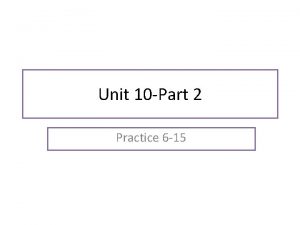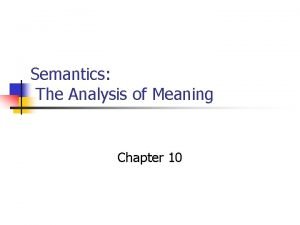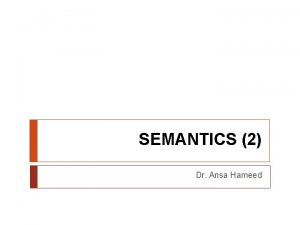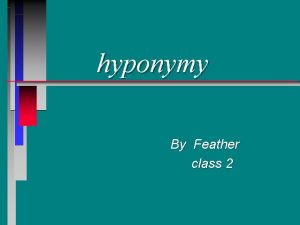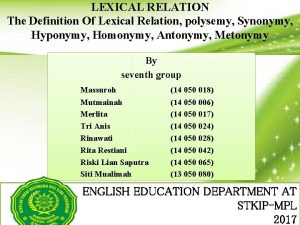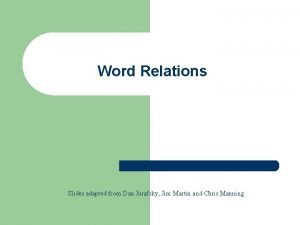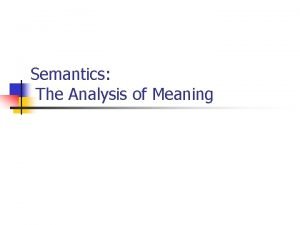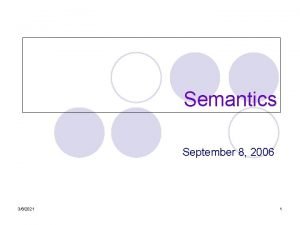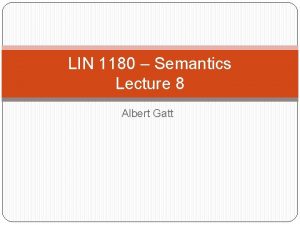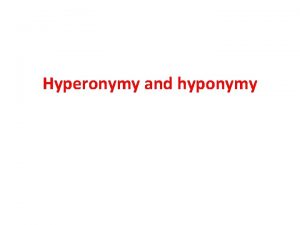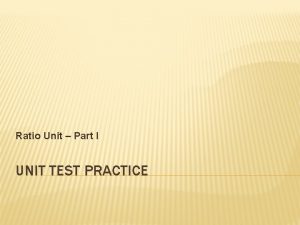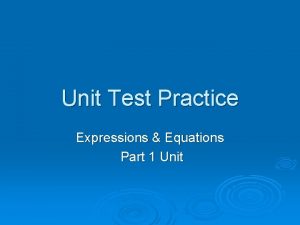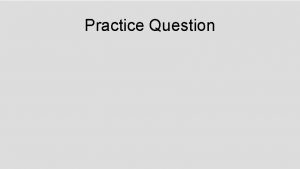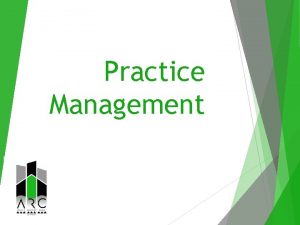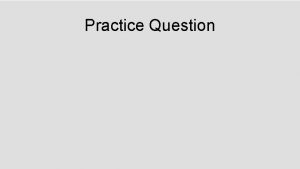Unit 10 Part 2 Practice 6 15 HYPONYMY


















- Slides: 18

Unit 10 -Part 2 Practice 6 -15

HYPONYMY is a sense relation between predicates (or sometimes longer phrases) such that the meaning of one predicate (or phrase) is included in the meaning of the other. The meaning of red is included in the meaning of scarlet. Red is the superordinate term; scarlet is a hyponym of red (scarlet is a kind of red). Practice Look at the following, and fill in some missing hyponyms. (1) pig (3) virtue sow ________ honesty _________ (2) tree (4) emotion beach _______ fear ______

Hyponymy is defined in terms of the inclusion of the sense of one item in the sense of another. We say, for example, that the sense of animal is included in the sense of cow. This inclusion can be shown roughly by a diagram giving a list of the ‘sensecomponents’ of cow. It will be seen that this list includes the component ‘animal’. But paradoxically ANIMAL sense of animal sense of cow BOVINE FEMALE perhaps, if we draw a diagram of the extensions of cow and animal, the inclusion relationship appears the other way around. the set of all cows the set of all animals

Practice (1) Which of the following descriptions is the more specific? (a) A man, 5 ft 8 in tall, with black hair, moustache, no beard, wearing a beige duffle coat, blue jeans, and lace-up shoes (b) A man in a duffle coat (a)/(b) (2) Which of the above descriptions gives more information? (a)/(b) (3) Which of the above descriptions describes more men? (4) In general, does giving more information increase or reduce the range of things described? (a) / (b)

We define HYPONYMY in such a way that SYNONYMY counts as a special case of hyponymy. For example, given two synonyms, such as mercury and quicksilver, we say for convenience that these also illustrate the hyponymy relationship, and that mercury and quicksilver are hyponyms of each other. Thus synonymy can be seen as a special case of hyponymy, i. e. SYMMETRICAL HYPONYMY. (X) mercury (Y) quicksilver (X) mercury If X is a hyponymy of Y and if Y is also a hyponymy of X, then X and Y are synonymous.

A proposition X ENTAILS a proposition Y if the truth of Y follows necessarily from the truth of X. We extend this basic definition in terms of propositions to cover SENTENCES in the following way. A sentence expressing proposition X entails a sentence expressing proposition Y if the truth of Y follows necessarily from the truth of X. John ate all the kippers (X) entails Someone ate something (Y). John killed Bill (X) entails Bill died (Y). . It is not possible to think of any circumstances in which sentence X is true and sentence Y false.

In all of our exercises on entailment it must be remembered that the truth of sentences (and of propositions) is relative to particular sets of circumstances, or states of affairs. Look at the following and circle the statements of entailment as correct (C) or incorrect (I). (1) John cooked an egg entails John boiled all egg. C / I (2) John boiled an egg entails John cooked an egg. C / I (3) I saw a boy entails I saw a person. C / I (4) John stole a car entails John took a car. C / I (5) His speech disturbed me entails His speech deeply disturbed me. C / I

Entailment applies cumulatively. Thus if X entails Y and Y entails Z, then X entails Z. (Technically, entailment is a transitive relation. See Unit 18. ) X, Some boys ran down the street entails Y. Some kids ran down the street Y, Some kids ran down the street entails Z, Some kids went down the street Therefore, X, Some boys ran down the street entails Z, Some kids went down the street.

Two sentences may be said to be PARAPHRASES of each other if and only if they have exactly the same set of ENTAILMENTS; or, which comes to the same thing, if and only if they mutually entail each other so that whenever one is true the other must also be true. John and Mary are twins entails Mary and John are twins; Mary and John are twins entails John and Mary are Twins. Therefore, John and Mary are twins is a paraphrase of Mary and John are twins.

Look at the following pairs of sentences and see if they have the same set of entailments (Yes) or not (No) (i. e. see if they are paraphrases of each other). 1) No one has led a perfect life • Someone has led a perfect life Yes /No (2) We've just bought a dog • We've just bought something Yes / No (3) The house was concealed by the trees • The house was hidden by the trees Yes /No (4) I ran to the house • I went to the house Yes /No (5) It is hard to lasso elephants • Elephants are hard to lasso Yes /No

Fill in the chart with the words entailment, paraphrase, hyponymy, and synonymy in the appropriate boxes, thus summarizing their relationship. The relationship between entailment and paraphrase is parallel to the relationship between hyponyrny and synonymy, as you will have noticed; Paraphrase is symmetric (i. e. two-way) entailment. Not necessarily symmetric (i. e. can be 'one-way') Symmetric (i. e. 'both ways') Relation between pairs of sentences pairs of words

Now we explore further the relationship between hyponymy and entailment . (1) In terms of the concepts you have now learned, what can you say about the relationships between the words in column A below and those in column B? • A B • tulip flower • sheep animal • steal take • square rectangular • (2) What can you say about the relationship between the A sentences and the B sentences below? • A B • Henry was chewing a tulip Henry was chewing a flower • Denis got savaged by a sheep Denis got savaged by an animal • David stole a pound of beef David took a pound of beef • Mary climbed through a square Mary climbed through a rectangu- hole in the roof lar hole in the roof.

In simple cases such as these, there is a clear rule that can be stated about the relation between hyponymy and entailment. Given below are three attempts at stating this rule. Only one of them is actually correct. Which is the correct rule? Circle your choice. a) Given two sentences A and B. identical in every way except that A contains a word X where B contains a different word Y, and X is a hyponym of Y, then sentence B entails sentence A. (b) Given two sentences A and B, identical in every way except that A contains a word X where B contains a different word Y, and Y is a hyponym of X, then sentence A entails sentence B. (c) Given two sentences A and B, identical in every way except that A contains a word X where B contains a different word Y, and X is a hyponym of Y, then sentence A entails sentence B.

The Basic Rule of Sense Inclusion does not work in all cases. There are systematic exceptions when certain logical words, such as not and all, are involved. We look first at cases with not (and n't), i. e. , cases of negative sentences. (1) What is the relationship between the A sentences and the B sentences below? A B Henry was not chewing a tulip Henry was not chewing a flower Denis didn't get savaged by a sheep Denis didn't get savaged by an animal David didn't steal a pound of beef David didn 't take a pound of beef Mary didn't climb through a rectangular hole in the roof square hole in the roof (2) Below is an unfinished version of a rule of sense inclusion for negative sentences. Finish the statement of the rule correctly. Given two negative sentences A and B, identical in every way except, that A contains a word X where B contains a different word Y, and X is a hyponym of Y, then

Now we look at sentences involving the word all, What is the relation- ship between the A sentences and the B sentences below? A B Henry chewed up all my roses Henry chewed up all my flowers All Denis’s sheep are sick All Denis's animals are sick Mary colored all the square Mary colored all the shapes purple rectangular shapes purple Part of the answer is: the B sentences entail the A sentences. But there is an important qualification that must be added to this. Can you think what it is?

We will mention one more case which presents problems, the case of gradable words: like big, tall, small, expensive etc. What are the entailment relations between the following sentences? A B John saw a big mouse John saw a big animal A tall pygmy came in A tall person came in We went in a small bus We went in a small vehicle That was an expensive That was an sandwich expensive meal

Summary • Hyponymy and synonymy are sense relations between predicates. • The latter is a special, symmetric, case of the former. • Entailment and paraphrase are sense relations between sentences, • The latter being a special, symmetric case of the former. • The sense relations between predicates and those between sentences are systematically connected by rules such as the basic rule of sense inclusion. • These sense relations are also systematically connected with such sense properties of sentences as ANALYTICITY and CONTRADICTION.

Assignment for Next Class Unit 11 Sense Relations 2 Practices 1 – 6 Review for Mid 2 Dec. 2 (D) and Dec 3 (C) Mid 2 in class Wed. 5 -12 -12 (No make-ups) Review for Final Dec. 16 (D) and Dec. 17 (C) Questions before the Final Wed. Dec. 19
 Basic rule of sense inclusion
Basic rule of sense inclusion Hyponyms
Hyponyms What is hyponymy
What is hyponymy Meronymy
Meronymy Hyponyms of meat fruit vegetable
Hyponyms of meat fruit vegetable Polysemy synonymy hyponymy and antonymy
Polysemy synonymy hyponymy and antonymy Hyponomy examples
Hyponomy examples Associative meaning in semantics
Associative meaning in semantics 10 examples of polysemy
10 examples of polysemy Hyponymy meaning
Hyponymy meaning Lexical universals
Lexical universals Hyponymy
Hyponymy Unit 10, unit 10 review tests, unit 10 general test
Unit 10, unit 10 review tests, unit 10 general test Addition symbol
Addition symbol Unit ratio definition
Unit ratio definition Brainpop ratios
Brainpop ratios Technical description meaning
Technical description meaning Considered as the heart of the entire beverage operation
Considered as the heart of the entire beverage operation The part of a shadow surrounding the darkest part
The part of a shadow surrounding the darkest part
